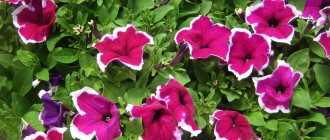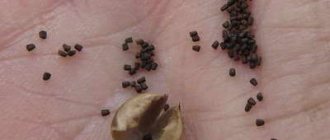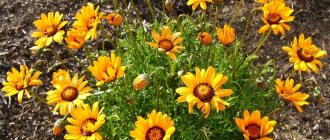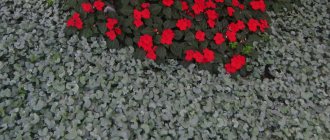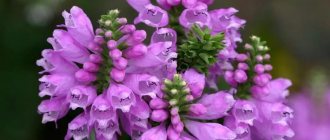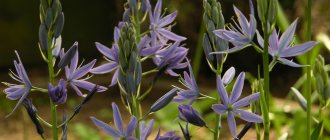Types and varieties of brachycoma with descriptions and photos
In places of natural growth - Australia, approximately 50 species of this plant are known, but flower growers most use two of them - iberisolia and multifidus, on the basis of which breeders have bred various, numerous varieties.
Brachycoma iberidifolia Brachyscome iberidifolia
Brachycoma iberidifolia photo
A low-growing openwork plant most common in garden plots. The height of the bush is 45 cm, the tops of the stems are crowned with flowers. An important condition is that it must be pinched at the seedling stage so that the bush does not stretch out. The specific name indicates the similarity of the foliage to Iberis evergreen.
Brachycoma Blue star photo
"Blue Star" - suitable for growing in hanging baskets and flowerpots;
Brachycoma blue baby
Brachicoma Waltz photo
Waltz is a variety mixture of soft blue, pink, lilac flowers with a dark center. Excellent decoration for borders and flower beds;
Brachycoma Swan Lake photo
Swan Lake is a variety mixture of white, blue, purple flowers, the bushes are literally strewn with beautiful pinnately dissected leaves. Suitable for decorating stone sculptures, can add unusual beauty to alpine slides;
Brachycoma Bravo photo
Bravo - a hybrid series has several colors of flowers, forms a densely branched, widely rounded, dense bush. The marginal reed flowers are ultramarine with a narrow light border at the base, blue, pink-lilac, violet and white. Tubular - small, black or yellow;
Brachycoma Margarita photo 1
Margarita - the shape of the flowers resembles miniature stars that have a dark core, and the petals can be pink, yellow, or lilac.
Brachycoma star scattering photo
An interesting variety, Star Scattering, with beautiful large flowers, the wide petals of which have a bright color. Purple, blue, and white flowers planted nearby really resemble a scattering of bright stars on a green background.
Brachycoma Magnificent photo
A good choice would be the Brachycoma Magnificent variety. This annual grows quickly, covering the flowerbed with luxurious inflorescences with many flowers.
Brachycoma iberisolifolia Nega photo
A stunning ampelous variety, which is convenient to grow on the balcony and in flowerpots, is Brachycoma iberisolifolia Nega: the plants are not tall, have very thick leaves and many flowers. real space for the gardener's imagination!
Brachicoma Palermo photo
A beautiful mixture of Brahicoma Palermo: soft pink, blue, purple flowers will delight you with abundant blooms all summer.
Brachyscome multifida
It is distinguished by narrow-lanceolate dissected foliage and the ability to grow well on rocky soils; for this ability it is also called “Mountain Chamomile”. Its height does not exceed 40 cm. The flowers are smaller than those of the previous variety, lilac-pink, white. There will be no problems with growing brachycoma multifidus even in a dry summer and without additional watering.
Brachycoma is successfully used as a camouflage agent - it perfectly covers perennial plants that have not survived the winter well, and fills the space after faded tulips, daffodils, and crocuses.
Brachyscome multifida variety Pacific Tide photo
It looks incredible as an independent plant near stones or borders - it has flexible stems, and they bend as they grow and form buds, creating the appearance of a waterfall of cascading flowers. It does not need additional watering, blooms profusely in dry and rainy summers, and takes root well on poor, rocky soils.
Brachycoma is suitable for beginner gardeners with its unpretentiousness, and will surprise the sophisticated with its decorativeness and modest elegance. Suitable for those summer residents who do not have the opportunity to constantly water and weed. Brachycoma is very impressive, but is not yet very popular among gardeners and deserves more attention.
Brachycoma iberisolifolia growing from seeds, planting and care photo
Brachycoma planting and care in open ground photo
Brachycoma flowers planting and care photo
When to sow brachycoma Planting brachycoma with seeds photo
Brachycoma ampelous cultivation and care photo
Brachycoma iberisolifolia flowers photo in the garden
Brachycoma varieties
More than forty species are known, but Russian gardeners prefer Brachycoma iberisolifolia to all others. Her homeland is Western Australia.
The most common varieties:
- "Margarita". This beauty can be recognized by its dark middle. It is almost black in color, and the petals are blue, pink, lilac, white or purple. It reaches a height of 30 cm.
- "Vinta Splender." Truly snow-white delightful flowers - a real “winter delight”.
- "Blue Baby" The name speaks for itself. In addition to the indicated colors, there is also a purple tone.
- "Pearl Splender" - luxurious unusual flowers of a rare dark purple color. A real garden favorite.
- "Blue Star" will color the flowerbed with a soft blue hue.
BlueStar
Mixtures of varieties that are popular among summer residents:
- "Waltz". A dark “heart” that can be bordered with a variety of colors. Pink, purple and blue will color the flower garden. The height of pets is up to 25 cm.
- “Swan Lake” (also called “Bliss”) gives the site a white-pink-blue glow.
- "Bravo" has a yellow or dark brown center. The shades of the frame may be different.
- Summer Skies. Literally translated as “summer sky”. It is these delicate tones of flowers that will delight the summer resident. There are up to 5 thousand seeds in one gram!
- The second popular type can be considered multifidus brachycoma. It can grow even on rocky, poor soils. Differs from other varieties by narrowly lanceolate dissected leaves. The petals are very narrow - up to 1 mm. The bushes grow within 40 cm.
Important! When choosing a suitable variety in a store, be sure to read the information on the packaging. There the growing conditions will be indicated, which should coincide with the climate in the given region.
This beautiful, unpretentious annual will decorate the area and does not require careful care. If brachycoma is chosen as a permanent resident at a dacha in central Russia, then it is important to remember all the stages of growing it from seeds and consider when it is better to plant heat-loving seedlings in open ground.
Brachycoma flowers description, photo
This guest from sunny Australia is a perennial and belongs to the Asteraceae family. But in the climatic conditions of Russia it is grown as an annual plant, since it does not tolerate severe frosty winters. In the southern regions, it adapts to weather conditions without any particular difficulties and pleases its owners for several years. It is not popular among summer residents, but in vain, because this flower is absolutely not capricious.
A branching but compact bush with an average height of only 25 cm. However, there are quite varied specimens - from 15 to 40 centimeters. Small openwork bright green leaves. Beautiful flower baskets - about 3 cm in diameter and very similar in appearance to chamomile. There are different colors - white, pink, blue, purple, lilac. At the same time, it exudes a delicate and attractive aroma.
The flowering extravaganza lasts about three months. It all starts in mid-June. One plant produces up to one hundred inflorescences, which differ slightly depending on the location. In the center - tubular, on the periphery of the bush - reed. The period of maximum decorativeness lasts about four weeks, and then gradually begins to fade away.
Diseases and pests of brachycoma
In some cases, the base of the brachycoma rots. This occurs from overwatering. The cause of this problem may lie not only in improper watering and poor drainage. The stem will rot if the summer is damp. This problem is also familiar to those who grow brachycoma in pots on the balcony or veranda. If this happens, the plant should be replanted, ensuring good drainage in the pot, and lifeless stems removed.
The flower is resistant to pests; parasites very rarely bother it. Sometimes you can find snails on the brachycoma, which spoil its appearance by forming holes on the leaves. The best way to get rid of them is to collect them manually, but if you want, use chemicals. If you try to grow this unpretentious and beautiful plant, you will probably never part with it again.
Reproduction options
Brachycoma can be propagated by seeds and cuttings. Both options have their own characteristics.
Seeds
How to propagate this plant by seeds in containers was discussed earlier in this text. In addition, seed material can be sown directly into open ground. Seeds can be purchased at a specialty store or simply collected on your site. This should be done in early autumn. If the seeds are not collected, they will be able to sow on their own and germinate the next year.
If a hybrid brachycoma was planted on a personal plot, then you should refrain from growing from such seeds. Indeed, as a result, the plant will not be able to retain its varietal characteristics. In addition, the number of flowers in the bush will be minimal.
In any case, it will be possible to sow seeds in open ground only when the threat of frost has completely passed. Most often this is done in early May. First you need to dig up the area prepared for the brachycoma, then make shallow furrows.
To learn how to sow brichocoma, see the following video.
Cuttings
Those who want to increase the number of brachycoma on their site, as well as preserve all its varietal qualities, need to use a propagation option such as cuttings. First you need to cut cuttings, the length of which will be at least 10 centimeters. It is best to use the parent bush for this. This process should be carried out in early spring. Cut cuttings should be placed in a container with a root growth stimulator for 6-8 hours.
In the meantime, you can start preparing the substrate. To do this, you need to mix sand and any fertile soil in equal proportions and pour it into containers. The finished cuttings must be carefully placed in the prepared soil and placed in a warm and well-lit place.
Propagation by cuttings
Even though in our climate it is impossible to grow most perennial plants without problems, there is no need to abandon your favorites every winter and grow new ones in the spring. Also, it is not necessary to collect seeds that will germinate easily but will not replicate the parent variety.
Propagation by cuttings will help preserve your favorite flowers and plant them again in the same place with the onset of the next season:
At the end of the season, the most lush and beautiful bushes are transplanted into separate pots. So, in pots, they can remain in the garden for some time, but with the onset of the first significant cold weather it is time to move them into the house.
Preparing a bush for wintering involves cutting off most of its crown, so that a small stem with leaves remains. In this form, the sprouts are stored in a cool place until spring.
The sprouts need to be watered a little, literally, so that the soil does not dry out.
In spring, seedlings are cut into 8 cm cuttings and the lower part is cleared of leaves - it will give a new root.
The cut cuttings with their lower cleaned part are placed in the root solution for 5-6 hours.
The finished cutting is buried in the sand for rooting.
When the cuttings take root, they are transplanted into good soil and cared for like ordinary seedlings.
Planting and growing from seeds
The brachycoma flower is not at all capricious, so planting and caring for it is easy. However, you need to adhere to certain rules, as there are some features. It is best to stock up on seeds in the fall. They can be stored for no more than 3 years, and only in small fabric bags. It is better to start preparing for planting at the end of winter.
Here are the basic rules to follow:
- 1To get seedlings, you need to prepare shallow containers in which the seeds will be planted.
- 2Seeds should be distributed over a moist substrate. There is no need to deepen them too much.
- 3The container should be covered with film or glass.
- 4The air temperature must be approximately 19°C for the seeds to begin to germinate.
- 5The room where the containers are located needs to be ventilated periodically.
- 6 Spray the seedlings.
- 7The first shoots appear a week after planting. You need to wait until all the plants sprout, and then at least 2 leaves appear on them.
- 8After this, transplant into different containers or into one large pot, but so that the distance between the sprouts is 5 cm. This procedure is called picking.
- 9After picking, watering should be regular. This rule also applies to feeding - about 2 times a week, but in small doses.
- 10Before transplanting seedlings into open ground, you need to harden them, that is, take them out into the fresh air, but the weather must be good.
Flowers should be planted when the weather has already become warm and stable. Usually this is the end of spring. If you count the number of days from planting the seeds to the appearance of the first inflorescences, then this is approximately 70 days.
You need to transplant seedlings into open ground along with soil from the pot. This will help the plant adapt faster to a new location and also prevent damage to the root system. Bushes should be placed at a distance of at least 0.2 m from each other.
Flowers can be grown at home. Quite often, brachycoma can be seen in pots. In addition, this way it will survive the winter well, and in the spring it can be transplanted into the garden. You definitely need to choose the right pot. Its diameter should be approximately 20 cm. As for the soil mixture, it includes: 1 part each of leaf soil and sand, 2 parts humus and 3 parts turf. Before pouring soil into the pot, you need to place drainage at its bottom - these are small pebbles or shards. After transplanting, you need to water the plant with the addition of mineral fertilizers.
How to collect brachycoma seeds
By autumn, good, high-quality seeds ripen. Once collected, they are placed in fabric bags and stored until spring. As a rule, it is possible to collect a large number of seeds. It is better not to buy store-bought seeds in bags. They come across a mixed variety. Using them, you will get unequal bushes of different colors. It looks very impressive, but if you want to grow flowers of a certain color, you should find planting material of the same variety.
There are different types of brachycoma. Some of them are intended for growing on ridges and hanging vases. Others decorate flower beds, flower beds, borders and alpine slides. In any case, the brachycoma looks great. Flowers look good against the background of hanging plants.
Latest articles about gardening
Pickling cabbage in February 2021 according to the lunar calendar
How to treat pepper seeds with hydrogen peroxide before planting seedlings?
Treating pepper seeds with potassium permanganate before planting seedlings
Description and characteristics of brachycoma
The best decorative properties of brachycoma can be observed in the iberisolifolia variety. It is usually used to decorate the garden. This is a herbaceous annual plant that will grow thickly in small, pleasant-smelling inflorescences in the area. At the same time, up to a hundred buds can bloom on a separately growing bush. They come in all shades of purple and blue, sometimes pink and white. Brachycoma blooms from the first to the last days of summer.
Brachycoma is an annual plant
Characteristics of brachycoma iberisolifolia:
- The leaves are thick, tender, thin, with deep dissection. Color - rich green.
- The height of the plant is small, up to 40 cm.
- Breeders have developed many varieties of this variety of brachycoma with different flower colors. For example, Bravo or Magenta Delight.
Advice. In rocky areas, florists sometimes grow brachycoma multifidus or mountain chamomile. Its flowers are even smaller, pink, purple or white in color, and its leaves are even narrower.
Popular varieties
The genus Brachycoma has 50 species of flowers. However, experienced gardeners love Brachycoma iberisolifolia, since all other varieties are created on its basis. Today the following varieties are known:
- Blue Star ;
- "Bravo Mixed" ;
- "Summer Skies" ;
- "Purple Splendor" ;
- "Waltz" .
Growing from seeds
If you want brachycoma to bloom in summer, growing from seeds must begin in winter. It is optimal if you sow the seeds at the end of February. It is during this period that work on growing seedlings of this plant should begin.
Brachycoma seeds have a very high germination rate, and therefore there are no problems with growing seedlings. The seeds of the plant remain viable for up to three years.
If your region has a warm, mild climate, then you can sow brachycoma seeds in open ground immediately in the spring. As soon as warm weather arrives, brachycoma can begin to be sown. In the middle zone, brachycoma flowers are grown in seedlings, since after the first shoots appear, the bushes will bloom only after two to three months.
Growing seedlings
Seeds are sown in pre-prepared containers or boxes. The boxes must be filled with a light and nutritious substrate prepared specifically for seedlings. The soil in the boxes should be compacted a little and spilled with a weak solution of potassium permanganate. Brachycoma seeds are too small, and therefore before sowing they can be mixed with sand or scattered over the surface of the soil. After the seeds are sown, the boxes must be covered with glass or covered with transparent film. The containers are placed in a warm and bright place. It is optimal if the room temperature is not lower than 18-20 degrees. Seedlings must be constantly (every day) sprayed and ventilated.
When the first true leaves appear on the seedlings, the young plants will resemble dill sprouts in their tenderness. As soon as the real leaves begin to develop, the seedlings should be planted in separate pots. It is best to use peat pots for seedlings for these purposes, with which you can then plant the plant in a permanent place in the garden. You can also plant seedlings in boxes, but in this case you should leave a distance between plants of at least 5 cm. When picking, you need to dig up the plant with a spatula, remove the young bush from the soil, clean the main root from the ground and pinch it. Then the plant can be planted in the hole in a new place. The roots are sprinkled with earth, the soil is lightly compacted, and then moistened with a spray bottle.
It is necessary to water tender brachycoma seedlings very carefully; it is best to use a syringe for this. Twice a month, from the moment the true leaves appear, the seedlings must be fed with complex mineral fertilizers specifically for flowering plants. When the sprouts reach a height of 5-6 cm, they need to be pinched so that the result is lush bushes. When warm days arrive in the spring, the seedlings begin to be hardened off by moving the pots to fresh air and a shaded place protected from drafts.
Planting seedlings
Planting and caring for this plant is really very simple. Already in the first days of May, stronger plants can be planted in a permanent place in the garden. It is ideal if you choose an open sunny area or light partial shade for brachycoma. This plant prefers loose soil with good breathability and moderate moisture. The selected area must be dug up before planting young plants. It is advisable to make a small drainage in the planting holes, since brachycoma does not like stagnant water.
If you grow brachycoma on your site in large flowerpots, you can fill them with the prepared mixture - then the plants will grow well and bloom profusely. When planting seedlings in open ground, the plants are placed at least 20 cm apart from each other. If you sow seeds directly into a garden bed, you will have to thin out the seedlings as soon as the real leaves appear.
Planting brachycoma in the ground
When to plant
Brachycoma seedlings are planted in the garden at the end of May or beginning of June, when the threat of return frosts has passed, warm weather has set in and the soil has warmed up. Before planting, seedlings must undergo two-week hardening procedures: they are taken out into the open air every day, protected from wind, drafts and precipitation. Gradually, the duration of the walks is increased until the plants can remain in the garden around the clock.
In the photo: How brachycoma blooms in the garden
How to plant
The brachycoma flower prefers partial shade in the southern part of the garden and loose, light, dry fertile soils. Make holes at a distance of 20-25 cm, throw a handful of expanded clay into each so that when watering the water does not stagnate in the roots of the brachycoma, place a peat pot with a plant or a seedling with an earthen ball on the roots on the drainage layer and fill the remaining space of the hole with earth. After planting, lightly compact the surface and water the area.
- Large trees: advantages and features of planting in a suburban area
Growing brachycoma from seeds
Sowing seeds
In areas with short summers, where autumn colds come early and spring comes very late, it is recommended to grow brachycoma only with the help of seedlings. At home, seedlings will be able to grow stronger and gain strength before planting in an open flower garden. The first flowering can be expected approximately 18 days after the young plants emerge.
Seeds can be sown from early March to mid-April. It is important to take into account the climate of the region. Seeds can be sown in ordinary plastic or wooden containers, but experienced gardeners advise using peat pots, as these delicate and fragile flowers react negatively to transplantation. A container made of peat allows you to keep plants safe and sound and does not require their removal when moving them to a flower bed or flower garden.
To sow seed material, you will need a loose soil mixture with moderate moisture, intended for growing seedlings or flowering garden plants. The seeds must be scattered randomly over the surface of the substrate, and then lightly press each seed 1-2 mm with your finger. The crops are sprinkled with coarse river sand, sprayed with a fine sprayer and the containers are covered with glass or thick polyethylene.
Brachycoma seedlings
Before the seedlings appear (for 10-15 days), the planting boxes and peat pots should be kept in a dark and warm room with a temperature of at least 22-23 degrees. When the sprouts appear, the glass or film should be removed and the crops should be moved to a bright room with bright and diffused lighting. Within 2-3 weeks, the seedlings require regular moistening, which is carried out using a spray bottle. You can use watering through a tray
To prevent the substrate from compacting, it is recommended to loosen it frequently and carefully, without touching the young shoots
After the formation of 2-3 full-fledged leaves on the seedlings, it is necessary to pick. One or two plants can be planted in individual containers. The first fertilizing is applied 7-10 days after picking. Complex mineral fertilizers are diluted to a weak concentration and applied along with irrigation water to each plant.
To give shape and for active bushiness of plants, it is advisable to carry out the pinching procedure during the period when the height of the crops reaches the five-centimeter mark. This will also help thicken and strengthen the stems.
Autumn care, seed collection and wintering
After flowering ends in September, the seeds ripen. They can be collected for future sowing. They remain viable for 2-3 years. The seeds need to be dried in a dark place. Then store them in a cloth bag in a cool place.
Although brachycoma is considered a perennial, it is not left in open ground for the winter. In most cases, dried bushes are dug up and thrown away in the fall, and the area is prepared for future spring sowing or planting of seedlings.
But you can save the bush until spring. Carefully dig it up, cut the shoots in half, transplant them into a suitable pot and put them in the cellar. It needs to be watered occasionally in winter so that the soil does not dry out completely. With the onset of warm weather, brachycoma is planted in a previously prepared area.
Description of the plant
We recommend that you read
Brachycomas belong to the Asteraceae family, although in appearance they are more reminiscent of daisies. This graceful plant is an annual; there are only a few varieties that are perennial. Flowers are branched. The leaves are openwork, narrow. They are small in size. Shade green. The bush has many small inflorescences that resemble baskets in shape. Their diameter is no more than 40 mm. The flowers have a reed appearance. The petals are arranged in one row. They can be whitish, pinkish, violet, lilac, blue. If the flowers are tubular, then they can acquire a blue or even black color. The flowering itself is abundant and long.
The aroma of brahicom is subtle and pleasant. Up to 100 small inflorescences can bloom on one bush. In autumn the seeds begin to ripen. They can maintain their germination capacity for up to 2-3 years.
The most popular brachicom varieties are:
- 1Iberisolifolia. This is the most common brachycoma, the cultivation of which is often practiced from seeds. Only 1 year makes a person happy. Grows up to 25 cm in height. The plant itself is very compact, but branched, so it turns out to be a small fluffy flowering bush.
- 2Nega. The inflorescences are white, blue and pink.
- 3Waltz. It has a dark pinkish or lilac hue.
- 4Blue baby. It is distinguished by the small size of the inflorescences, and their color is blue (in rare cases with a purple tint).
- 5 Blue tenderness. Another variety with soft blue inflorescences.
- 6Swan Lake. This is also a very popular variety to grow. Inflorescences are lilac, purple, white.
- 7Margot. The inflorescences are star shaped. Its core is dark, and the petals can be blue, lilac, pinkish or white.
All these varieties go well with other plants, so brachycoma is often planted in compositions in flower beds and balconies.
How to grow Brachycoma seedlings?
It is recommended to sow Brachycoma seeds for seedlings at home in early March. The soil for sowing should be light and fertile. You can use store-bought, but it’s better to make your own. To do this, take 1 part of river sand and leaf soil, 2 parts of humus, 3 parts of turf soil and a little mineral fertilizer.
Seeds should be sown in shallow containers filled with slightly moistened soil. Shallow grooves are made on top of the soil, and seeds are laid out in them. It is not recommended to sprinkle seeds with soil.
The containers are covered with glass or transparent film (lid) and placed in a bright, warm place. The optimal air temperature for seed germination at home is approximately +20°C. As a rule, they sprout within 8-12 days from the moment they are sown.
As soon as the sprouts have 2-3 leaves, they will need to be picked
Brachycoma seedlings tolerate picking well, but replanting must be done carefully so as not to damage the very thin sprouts. Watering is best done using a spray bottle
It is better to transplant seedlings into separate cups or seed boxes. The distance between sprouts should be at least 5 cm.
As soon as the seedlings get a little stronger, they will need to be taken out into the fresh air to harden them. Increase the time spent in the air each time.
How to choose a place for brachycoma
Absolutely any loose and moderately nutritious soil is suitable for it. The ideal place is as close as possible to sunlight and warmth, the southern part of the garden. By the way, light partial shade is just right for it, since in the afternoon heat the flower is not very hot, and there is enough light for growth.
If you are interested in brachycoma, cultivation can be carried out either on the balcony or on the veranda - bright flowers (brachycoma is similar to daisies and daisies) will decorate your favorite vacation spot! The Swan Lake variety is especially popular.
How to grow a date palm from a seed
The date palm will decorate any interior, and planting material is always at hand! Pits from fresh or dry dates are suitable for planting. Separate them from the pulp and place them in a glass of water for 1-2 days, which you change for fresh water about once a day. After this procedure, the remaining pulp is easier to remove from the stone. This will reduce the likelihood of rotting. Now the seeds are ready for planting.
Palm soil can be purchased at a garden store. Plant the seeds vertically with the sharp end up to a depth of 3-4 cm. Cover the container with film or glass. Moisten the soil periodically, preventing it from drying out. In a couple of weeks, the sprouts of the future luxurious palm tree will hatch.
Young plants need to be accustomed to indoor conditions immediately, so gradually remove the cover. Avoid overwatering and drying out the soil. You should also refrain from fertilizing. After the true leaves appear, pick up the seedlings into separate containers. It is better to place the plants on a western or eastern windowsill. As soon as the palm tree begins to grow, you can feed it with complex fertilizer.
Conditions for growth
To admire the beautiful brachycoma flowers in your garden, when growing, you need to create for them the basic conditions necessary for their normal growth and development, which include light, air, heat, water and nutrients in the soil.
Lighting
Brachycoma is a light-loving plant, so it is better to plant the flower so that it is exposed to the sun most of the time and is also protected from the wind as much as possible. The ideal solution would be to allocate the southern part of the garden plot to the plant.
Priming
The culture grows well on light sandy and fertile soils. Does not tolerate excess moisture, as stagnant water causes rotting of the roots. Therefore, when planting, you need to make sure that the soil is well drained.
Reproduction of trachycarpus by lateral processes
Reproduction of trachycarpus at home
It is safer to root the shoots. Please note that they appear when there is sufficient air humidity in the room. The process must have a diameter of at least 7-10 cm. As a rule, it is located at the base of the palm trunk.
- Carefully separate the side shoot using a sharp knife at the narrowing of the trunk, trying to minimally damage the mother plant; sprinkle the cut area on the palm tree with charcoal or treat it with a phytosporin solution.
- Then remove the separated shoot from the leaves, also treat it with phytosporin at the cut site, and dry it for 1-2 days.
- Keep the dried shoot in a solution of a growth stimulator for a day, then plant it in a small container with palm soil mixed with perlite or coarse sand.
- Warmth and high humidity are required: cover the planted shoots with a bag and maintain the temperature at about 25 °C.
- Do not forget about daily ventilation, water moderately as necessary. Even under such conditions, rooting can last about 6 months, because the roots grow slowly.
- After six months or a year, when new leaves appear, the rooting process can be considered successful, the plant is transferred to a pot with soil for adult plants.
The best varieties
There are more than 50 varieties of the crop, but gardeners are particularly interested in Brachycoma iberisolifolia when creating landscape design, on the basis of which various plant varieties have been bred.
Iberisolia (Brachycome iberidifolia)
This species is presented as a small branching bush, reaching up to 40 cm in height. The plant is decorated with thin, openwork foliage
Flowers of different varieties attract attention, the colors of which can be white, blue, violet, purple, pink. Tubular flowers have a distinct blue color
Flowering occurs in July and lasts until mid-autumn.
Multifid (Brachycome multifida)
Compact perennial up to 45 cm high. The foliage is green, deeply cut, pinnate, 3-6 cm long. Flowers painted lilac, pink or white, with numerous thin and narrow petals, fascinate the eye. A distinctive feature of the species is the active rooting of plants when the stems come into contact with the soil. Forms a small number of seeds that have low germination.
Mega blue
An elegant perennial flower with unique purple and bright blue inflorescences in the shape of a basket with a dark center and white edging, which are located at the ends of the shoots one or several pieces. Thin stems are covered with foliage having a solid surface. Pleases with luxurious flowering in mid-summer.
Blue
A compact bush strewn with pale blue inflorescences with a yellowish center, 1.5-2 cm in diameter, which stand out against the green background of openwork foliage. The leaves are entire or pinnately divided, and are in alternate order. Begins to bloom in mid-July.
Swan Lake
A beautiful, graceful plant up to 25 cm high. The bush is highly branched, covered with delicate, pinnately dissected foliage and dotted with numerous flowers, collected in inflorescences-baskets 3 cm in diameter. The flowers are reed-shaped and have a varied palette of shades. Abundant flowering begins in June and continues until the onset of autumn frosts.
For every gardener, brachycoma will be a real find. This unpretentious plant will delight you with luxurious flowering all season long. And the varied palette of shades of inflorescences is a great opportunity to let your imagination run wild when creating unique living compositions.
Care
At home, caring for brachycoma will not be so difficult, because it practically does not require much attention. Like any other plant, it needs watering, fertilizing, pruning, and loosening the soil. In addition, before the onset of the first frost, if the brachycoma is still blooming in the flowerbed, it can be transplanted into pots and brought into a warm room. In this case, she will be able to please everyone present with her beauty for some time.
Watering
This process is very important for any plant. After all, moisture is necessary for all living things. You don’t need to water too often, because brachycoma loves dry soil more than waterlogged soil. Watering is carried out with warm water, which can be heated in the sun. It is best to do this in the morning or evening, when there is no sunlight.
Top dressing
Fertilizers must be applied 3-4 times per season. You can use both organic and mineral fertilizers. Wood ash, diluted chicken droppings or manure are suitable first. However, organic fertilizers must be diluted in water. If mineral fertilizers are used, they can be purchased at any flower shop in accordance with the time of the season. The last feeding is done in early autumn.
Bush formation
The plant needs pruning so that it can bloom more luxuriantly and abundantly. The best way to do this is to pinch the top of the brachycoma. It is also necessary to regularly prune all inflorescences that have already faded. This will make the bush more luxuriant.
Soil treatment
The soil needs constant weeding, because the plant must receive the proper amount of air. If this is not done, the root system will slow down its development slightly, which will immediately affect the growth of the bush. When doing this, you need to make sure that the hoe does not touch the roots that are located too close to the surface. In addition, loosening will help cope with weeds, which take many useful substances from the soil.
Brachycoma: plant care
Even a novice gardener can grow brachycoma. The plant is not demanding to care for. This plant is adapted to dry soil and drought, so it does not need frequent moisture. Excess moisture will cause brachycoma to rot and die.
Brachycoma prefers a bright sunny area. The Australian pedigree of the culture shows.
Throughout the season, the plant should be fed only three times.
. For the first time, it is recommended to use a low concentration universal fertilizer. The second time it is recommended to use wood ash. At the time of flowering, brachycoma will respond well to fertilizing with organic fertilizers.
BRACHYCOMA. PETUNA'S BEST COMPANION - video
Advice!
To give the bush a pleasant shape, it is worth pinching the apical shoots. To stimulate the formation of new flowers, faded buds must be removed.
The culture responds well to loosening the soil, so the surface around the plants is periodically processed.
Rules for planting and care
Planting a plant in open soil begins in late spring, when sudden temperature changes are not expected. You need to wait about 70 days before the first flowering, but the wait is worth it.
Planting seedlings should be carried out with a clod of earth; the root system is not damaged with this method, and the plant will hurt less in the new place. The interval between two brachycoma bushes should be at least 20 cm.
Caring for such a plant does not require any special knowledge from you. All you need is to choose the right place and provide watering.
Brachycoma is a lover of a bright and spacious place with fertile soil. Over-watering should not be allowed; experts recommend providing this place with good drainage so that the plant does not die.
If you grow brachycoma at home, then for its comfortable growth you need to choose a flower pot with a diameter of about 20 cm. The substrate for such a plant should consist of sand, turf, humus and leaf soil in a ratio of 1: 3: 2: 1.
Caring for such a plant consists of several points.
- Regular watering is necessary when active growth and development is underway.
- It is worth feeding the plant three to four times a month to increase its vitality.
- Do not forget to loosen the soil and destroy weeds, this will allow young plants to develop freely.
- Remove dried inflorescences and leaves.
- You can shape the plant by cutting off the branches.
If the region you live in has warm winters, then you have an excellent opportunity to save the plant for next year. To do this, you need to insulate the bushes with straw or spruce branches.
Caring for such a plant often involves treating it for various diseases or pests. Compared to other representatives of the flora, brachycoma is rarely susceptible to disease, but it will have to be saved from snails.
As you may have noticed, caring for such a plant does not contain anything specific or complicated. Standard techniques will help you decorate and transform your garden plot or balcony.
Possible difficulties and illnesses
Brachycoma is an unpretentious and hardy plant and is very rarely attacked by pests and diseases. But there are some problems with growing this plant.
Rotting of the stem or roots. The reason is excessive watering. This is especially true if the summer turns out to be rainy. Remember that brachycoma loves dryness, which is why we put drainage material under the bush. What to do to save plants? Just replant them in another location and provide excellent drainage, and remove any rotten stems.
Snail attacks. For some reason, garden snails are very fond of brachycoma. They gnaw through the leaves of the plant - by the characteristic holes you can tell that the flowers have been attacked by these gastropod parasites. What to do? Just collect all the snails found on the brachycoma bushes and throw them somewhere far away or simply kill them. Alternatively, the plants can be sprayed with parasite repellents - these can be found in gardening stores. But remember that chemistry is not always good for plants.
Whiteflies feed on plant sap
Whitefly infestation. The whitefly is a homopterous flying insect with wings of a characteristic white color (hence the name). The “parasite” reproduces very actively. It causes harm by leaving its feces on plants, corroding the surface of the stems and leaves. And whitefly larvae feed on plant juices. These parasites mainly affect indoor plants. You will have to fight insects using chemicals. Fortunately, whitefly infestations of brachycoma are extremely rare.
Nikolay Zhuravlev
Chief Editor
Author of publication 03/10/2016
Brief historical information
The history of the flower began at the end of the 17th century - it was then that the British naturalist (and part-time famous navigator and pirate) William Dampier brought the plant to Europe from Australia. It is not known why this wild chamomile captivated him (at that time the plant was not cultivated), but it attracted the attention of the public and was already very widespread in European gardens in the 19th century. Then interest in the plant fell somewhat (plants go in and out of fashion - this is a natural process), but today it is again popular. Breeders have also become interested in it, although at the moment no radically new varieties have been obtained. Nevertheless, almost every domestic agricultural company produces brachycoma seeds, and they are easily available for sale.
Abroad, the plant has a very beautiful romantic name - Swan River daisy.
Sources
- https://dachadizain.ru/cvety/odnoletnie/braxikoma-v-landshaftnom-dizajne.html
- https://sornyakov.net/flowers/braxikoma.html
- https://1decor.org/rasteniya/cvety/braxikoma-iberisolistnaya.html
- https://chto-posadit.ru/posadka-i-uhod-za-brahikomoy-kogda-seyat-semenami-na-rassadu-foto-sortov/
- https://domsad.guru/tsvety-rasteniya/b/brahikoma-posadka-uhod-vyrashhivanie-iz-semyan-foto.html
- https://proklumbu.com/otkrutui-grunt/odnioletniki/brahikoma-iz-semjan.html
- https://klumba.guru/sadovye-cvety/brahikoma-vyraschivanie-iz-semyan-posadka-i-uhod.html



